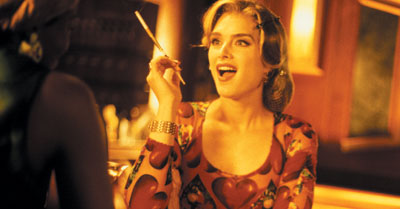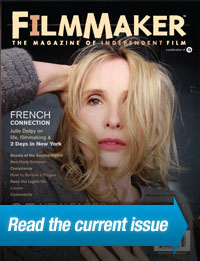FARSIGHTED
By Gill Holland
 |
| A Tom LeGoff still of Brooke Shields in Brian Skeet's The Misadventures of Margaret. |
When The Screening Room in Lower Manhattan abruptly went out of business this past October, famed film portraitist and on-set still photographer Tom LeGoff also lost his de facto gallery space. Since its opening in 1996, LeGoff’s shots of Jean-Luc Godard, Ang Lee, Christina Ricci, Vincent Gallo, Spike Lee, Darren Aronofsky and others have adorned the walls of the restaurant/moviehouse. On closing night, as fans of the space heard the news and streamed in for a final drink, LeGoff did a brisk business by literally selling his own prints off the walls.
LeGoff, whose photo show “The Independents” was exhibited at Sundance in 1999, returns to the festival this year — in the pages of the program book, where his still work can be found illustrating the Dramatic Competition film Marie and Bruce. Indeed, LeGoff can most often be found on film sets doing unit photography now, and even though indie films still are his specialty — and The Screening Room has since been purchased by the Tribeca Film Festival — he’s moving into a bigger-budget world where he’s not likely to be selling prints off the wall anymore.
“After shooting 20 movies I finally got into the union and now most of my jobs are ‘work for hire,’” Legoff explains. “Anything I shoot belongs to the production. I had to swallow a lot of pride coming straight from the photo industry [where photographers customarily own their negatives] to doing work for hire. You sometimes feel like you are just another cog in the machine.”
Between gigs, we asked LeGoff what tips he has for aspiring film still photographers, and here are his comments:
“Schedule a time with the actors to shoot fake scenes. On Hurricane Streets, I got the producers to let me have all the young actors for an afternoon, with a couple of fun outfits to wear, and we just hung out and took pictures — and these were the portraits that ended up being composited together for the MGM poster.
“Remember that most images are going to turn up as four square inches in newsprint so interaction between characters is key. Long shots with lots of background are usually not going to be used, so don’t even bother.”
 |
| A Tom LeGoff photo of Harmony Korine
on the set of Julien Donkey-Boy. |
“Know the script and the schedule so that you are there for the major dramatic scenes and for any guest-star appearances.
“On independent movies that can’t pay (is that a redundancy?) or can only pay with a small stipend, try to retain the rights to the negatives and pre-determine a fee to be paid for use of the images if the film is sold.This fee will be more if they want exclusive rights to the film, and less if they take non-exclusive. I have also done it where I shot the movies and only allowed the production the rights to use the images to sell the film, and then I dealt directly with the eventual distribution company. The down side to this is that the eventual distributor may decide not to buy the film and even commission new photographs from another photographer.”
VOD CALENDAR


 See the VOD Calendar →
See the VOD Calendar →


